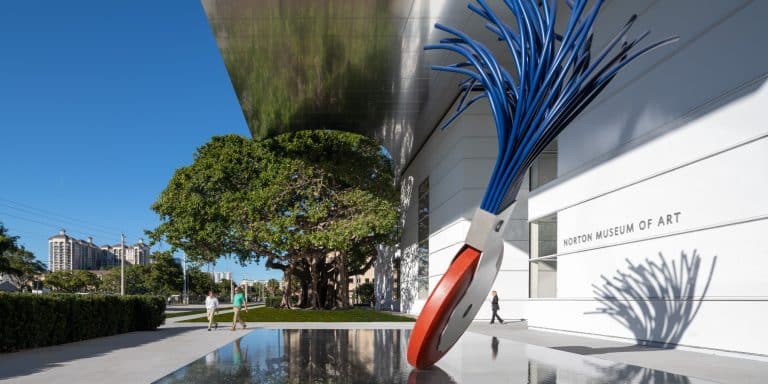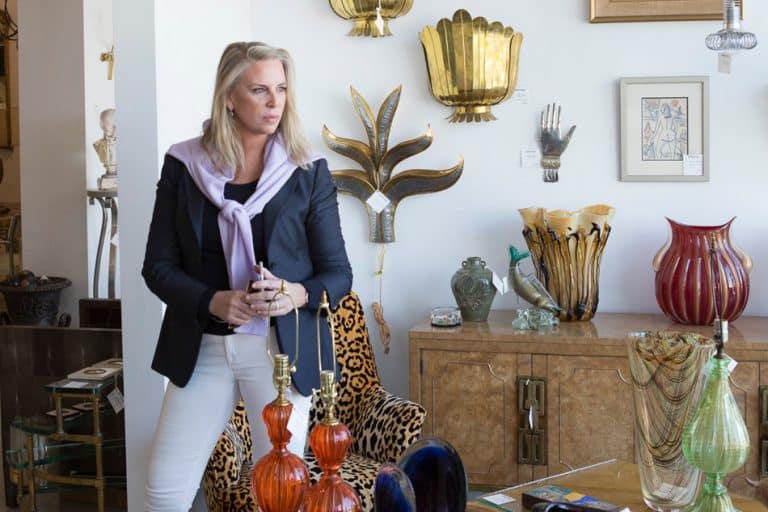
February 15, 2016A set of 11 carved palm trees from the 1930s, shown here (and top) at the Newel gallery showroom in Manhattan with a 1971 painting by Ray Parker, is now turning heads at the Palm Beach Jewelry, Art & Antique Show. It is priced at $950,000. All photos by Joshua McHugh, courtesy of Newel LLC., unless otherwise noted
One of the showstoppers at the Palm Beach Jewelry, Art & Antique Show running through February 16 in Florida is the palm-tree-lined booth of New York’s Newel gallery.
Nearly a dozen floor-to-ceiling palms, made around 1930, decorate the walls almost like pilasters. Just over 10-feet-tall, the sculptural trees are magnificent, their leaves outstretched like a ballet-dancer’s arms, the tips of one just touching those of the next. They are made of mahogany, with pale gray gesso covering the deeply carved, feathery fronds and incised imitation bark.
“We are pretty sure they were made in America because of the mahogany, which would have been imported from the West Indies,” says Guy Regal, executive managing director of Newel, an eclectic antiques and contemporary-art gallery, which recently moved to a new full-floor space in the Interior Design Building, on East 61st Street (also home to Liz O’Brien, Roark and Niall Smith, among others).
Provenance
The palms have a glamorous backstory. The New York decorator Marian Hall, of the firm Tate and Hall, commissioned them for Frances and Carl Schmidlapp, an investment banker who bought an apartment at the then-brand-new white-glove limestone building at 834 Fifth Avenue. Still considered one of the most exclusive residential co-ops in Manhattan, the 1931 building was designed by Rosario Candela, the preeminent apartment architect of the day. Other residents over the years have included Laurance Rockefeller, Rupert Murdoch, Charles Schwab, Loews Corporation heiress Laurie M. Tisch and Harold and Judy Prince. The Schmidlapps lived there until 1967, when Frances died.

New York decorator Marian Hall commissioned the trees for Frances and Carl Schmidlapp’s apartment at 834 Fifth Avenue. She drew inspiration from a tea pavilion on an English estate called Moor House. This original Robert Adam sectional drawing reveals his intentions for that elegant space. Courtesy of the Trustees of Sir John Soane’s Museum
According to Mark Hampton’s 1992 Legendary Decorators of the Twentieth Century, the Schmidlapps’ palm-tree room was inspired by a Robert Adam tea pavilion on an English estate. And in the 1964 tome The Finest Rooms by America’s Great Decorators, Hall herself writes, “Mrs. Schmidlapp and I found a beautiful oval Adam room at an old and distinguished furniture dealer in New York. This was installed as the reception room, and in the dining room next to it we carried out the Adam theme, copying the palm-tree motifs from the beautiful Adam tearoom at Moor Park, in Hertfordshire, England.”
Hall apparently knew her Adam sources well. Among some 8,000 Adam drawings at Sir John Soane’s Museum, in London, are a set designated as “designs and finishing drawings for a tea pavilion, 1763–65, as executed.” Frances Sands, catalogue editor of the Adam drawings project at the Soane, writes in her listing of the architect’s Moor House drawings: “Plan of the first floor, and section through a one-and-a-half storey ornamental cottage, with an octagonal central block containing a tea room ornamented with palm trees.”
The Soane has both the original Adam drawings and a 1912 photograph of the pavilion that appeared in Country Life. According to Sands, the palm trees were sold in 1933, as also noted in John Harris’s 2007 book Moving Rooms: The Trade in Architectural Salvage. (No one knows what became of them.) Marian Hall copied the Moor House palm trees faithfully, although Sands thinks the original ones would have been in plaster and the Hall palms were mahogany. “In 1930, fine wood carvers were ubiquitous the world over, while genuinely skilled plasterers were rare,” she notes.

The second owners of the Manhattan apartment, the Watson K. Blairs, hired Carlos Ortiz-Cabrera of Maison Jansen to update their dining room. His ochre-colored result made the cover of the 1971 book Jansen Decoration, a few copies of which are available on 1stdibs.
Back at 834 Fifth, the Watson K. Blair family, the next owners of the apartment, went to the Paris-based decorating firm Maison Jansen. As New York designer and amateur decorative-arts historian John J. Fondas says, “Josie Blair was an ultra-stylish New York lady, and she hired Jansen when the company was at its peak, with nine hundred in staff and the best clients in the world,” including the Windsors, the shah of Iran and Hollywood stars.
Mrs. Blair, born Mary Josephine Cutting, was the widow of Alexander McFadden. Their daughter, Mary McFadden, the New York fashion designer, recalls growing up in the apartment and the many parties her mother hosted. “I was completely conscious of the palm-tree room and the fact that Carlos Ortiz-Cabrera, of Jansen, decorated the apartment,” she says. “We also had a tent room. All the rooms were fantastic.”
Until now, it was wrongly assumed that Jansen installed the palm trees, because they grace the cover of the 1971 book Jansen Decoration. What the ever-innovative Jansen did do is paint the walls of the palm-tree room ocher and furnish it with an eclectic mix of modern glass and steel pieces, zebra rugs and Louis XV antiques. The trees remained in the apartment when cosmetics tycoon Charles Lachman, cofounder of Revlon, bought it in 1976. After Lachman died, his second wife, Jaquine, the Countess of Rochambeau, married Bob Arnold, and in 1986, the Arnolds sold the apartment to Wall Street tycoon John Gutfreund and his wife, Susan.
Jaquine Arnold missed the palm trees and had them replicated in plaster in the couple’s house, Lucaya, in Lyford Cay in the Bahamas. Told about the pieces’ impending sale, she says, “I would have taken them with me if I had known the Gutfreunds didn’t want them.”

Left: This 1912 photograph of the original Adam tea pavilion appeared in Country Life magazine. Photo © Country Life. Right: Designed in 1756 by architects John Vardy and James “Athenian” Stuart, the gilded palms in Spencer House, in London, are perhaps the most famous of all. Photo by Mark Fiennes, © Spencer House Limited

The palms sat in storage for 30 years, until fourth-generation Newel CEO Jake Baer bought them two years ago. It took a year to remove all the layers of paint and gesso in which they were encased.
The Gutfreunds hired the architect Thierry Despont and Paris decorator Henri Samuel to update the apartment. “The palm trees didn’t suit me,” Susan Gutfreund says. “I knew from the moment I bought the apartment that I had to change everything, so I sold them. If only I had known what they were worth!”
The palms languished in storage for 30 years, until Jake Baer, the fourth-generation CEO of Newel, bought them two years ago without knowing anything about their history. “We have a subspecialty in selling palm trees,” Baer says with a smile. “So people often offer us that type of material.”
Palms have been used as a decorative motif for hundreds of years. The most famous palm room is in London, in Jacob Rothschild’s city palace, Spencer House, which was begun in 1756 by the architects John Vardy and James “Athenian” Stuart for John, first Earl Spencer (an ancestor of Princess Diana). In that opulent room, the palm fronds are gilded. Palms adorn chandeliers, textiles and table and chair legs. “The palm tree motif was celebrated in the eighteenth century because it was seen to link nature and classical architecture,” says Sands, of Soane’s Museum, explaining the ornament’s popularity.
Condition
Thirty years in storage had taken a toll on the palm trees, so Newel hired the renowned Eduardo Larrea Studio, in the Bronx, to restore them. It took a year to remove all the layers of paint and gesso. Now, Regal says, “they have been returned to their original quality.”

The palms make a bold statement in Newel’s Manhattan showroom, along with an Austrian clock and Egyptian gilt armchair.
Rarity
The 11 palm trees (only 10 are on view at the fair) are a set and clearly unique. But they are not obscure. In fact, they are famous. Not only have they appeared in print, but they have been wildly admired by decorators like Bunny Williams, Miles Redd, Robert Couturier and Ellie Cullman. (Regal says Cullman saw them in the Newel warehouse and said, “I just finished a room they could have gone in!”)
Adds New York designer Fondas: “The palm-tree room is one of the most recognized ever. It was unbelievably chic and ultra-stylish. Everyone interested in twentieth-century design knows it.”
Price
How did Newel arrive at the $950,000 price? “We looked at all things comparable,” Regal says. “In terms of rarity and uniqueness, nothing compares. The set is one hundred percent one-of-a-kind. Paneled rooms with no provenance sell in the six-figure range, then add on the fact that these palms cost a great deal to restore. Plus, they are irresistible.”
In fact, 18th-century paneled rooms often cost well over $1 million.
Specialists like the Paris galleries Steinitz and Féau & Cie offer original French boiseries from the 17th century through the 1970s for millions. And the Schmidlapp palm trees are iconic. “We’ve never had a collection with this kind of story and history,” Regal says. “It’s incredibly rare.”


